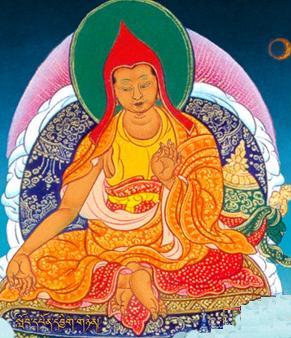Treasury of Abhidharma: Difference between revisions
Jump to navigation
Jump to search
mNo edit summary |
No edit summary |
||
| Line 1: | Line 1: | ||
[[image:Vasubandhu.JPG|frame|Vasubandhu]] | [[image:Vasubandhu.JPG|frame|Vasubandhu]] | ||
The '''Treasury of [[Abhidharma]]''' (Skt. ''Abhidharmakośa''; Tib. [[ཆོས་མངོན་པའི་མཛོད་]], ''Ngön Pa Dzö''; [[Wyl.]] ''chos mngon pa'i mdzod'') and ''Auto-Commentary on the Treasury of Abhidharma'' (Skt. ''Abhidharmakośa-Bhāṣya''). These works were composed by [[Vasubandhu]], one of the '[[Six Ornaments]]', the greatest Buddhist authorities of Ancient India. ''Abhidharmakosha'' is a complete and systematic account of the [[Abhidharma]], and is the peak of scholarship in the [[Fundamental Vehicle]]. | The '''Treasury of [[Abhidharma]]''' (Skt. ''Abhidharmakośa''; Tib. [[ཆོས་མངོན་པའི་མཛོད་]], ''Ngön Pa Dzö''; [[Wyl.]] ''chos mngon pa'i mdzod'') and ''Auto-Commentary on the Treasury of Abhidharma'' (Skt. ''Abhidharmakośa-Bhāṣya''). These works were composed by [[Vasubandhu]], one of the '[[Six Ornaments]]', the greatest Buddhist authorities of Ancient India. ''Abhidharmakosha'' is a complete and systematic account of the [[Abhidharma]], and is the peak of scholarship in the [[Fundamental Vehicle]]. It is included among the so-called "[[Thirteen great texts]]", which form the core of the curriculum in most [[shedra]]s and on which [[Khenpo Shenga]] provided commentaries. | ||
==Outline== | ==Outline== | ||
Revision as of 14:33, 24 May 2012

The Treasury of Abhidharma (Skt. Abhidharmakośa; Tib. ཆོས་མངོན་པའི་མཛོད་, Ngön Pa Dzö; Wyl. chos mngon pa'i mdzod) and Auto-Commentary on the Treasury of Abhidharma (Skt. Abhidharmakośa-Bhāṣya). These works were composed by Vasubandhu, one of the 'Six Ornaments', the greatest Buddhist authorities of Ancient India. Abhidharmakosha is a complete and systematic account of the Abhidharma, and is the peak of scholarship in the Fundamental Vehicle. It is included among the so-called "Thirteen great texts", which form the core of the curriculum in most shedras and on which Khenpo Shenga provided commentaries.
Outline
The text is divided into eight topics:
- The elements (Skt. dhātu)
- The faculties (Skt. indriya)
- The world (Skt. loka)
- Actions (Skt. karma)
- 'Subtle developers' (Skt. anuśaya) (i.e. negative emotions)
- The path and the individual (Skt. mārgaprahāṇa)
- Wisdom (Skt. jñāna)
- Meditative equipoise (Skt. samāpatti)
Commentaries
| This section contains Tibetan script. Without proper Tibetan rendering support configured, you may see other symbols instead of Tibetan script. |
Indian
- Yashomitra, Abhidharmakośaṭīkā (ཆོས་མངོན་པའི་མཛོད་ཀྱི་འགྲེལ་བཤད་, chos mngon pa'i mdzod kyi 'grel bshad)
Tibetan
The following are among the best known Tibetan commentaries on the Abhidharmakosha:
- Chim Jampé Yang, Ornament of Abhidharma (མངོན་པའི་རྒྱན་, mngon pa'i rgyan)
- Gendün Drup (1391–1474) Illuminating the Path to Liberation (ཐར་ལམ་གསལ་བྱེད་, thar lam gsal byed)
- Rongtön Sheja Kunrig, Thoroughly Illuminating What Can be Known (ཤེས་བྱ་རབ་གསལ་, shes bya rab gsal)
- Mipham Rinpoche, རིན་པོ་ཆེའི་དོ་ཤལ་བློ་གསལ་དགྱེས་པའི་མགུལ་རྒྱན་, rin po che'i do shal blo gsal dgyes pa'i mgul rgyan
- Jamyang Loter Wangpo, A Lamp Illuminating Vasubandhu's Intention (དབྱིག་གཉེན་དགོངས་པ་གསལ་བའི་སྒྲོན་མེ་, dbyig gnyen dgongs pa gsal ba'i sgron me)
- Khenpo Shenga, A Mirror for What Can be Known (ཤེས་བྱའི་མེ་ལོང་, shes bya'i me long)
Translations
Tibetan
- The Abhidharmakosha and its commentary were translated in the 8th century by Kawa Paltsek and the Indian pandita Jinamitra.
English
- Abhidharmakosabhasyam of Vasubandhu, translated by Leo M. Pruden, Asian Humanities Press, Berkeley 1990 (Translated into English from the French translation of Louis de La Vallé Poussin, L'Abhidharmakośa de Vasubandhu, Institut belge des hautes études chinoises, Bruxelles, 1971)
French
- Louis de La Vallé Poussin, L'Abhidharmakośa de Vasubandhu, available for free download from Archive.org
Further Reading
- James Duerlinger, Indian Buddhist theories of persons: Vasubandhu's "Refutation of the theory of a self", Routledge, 2003
